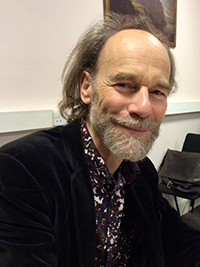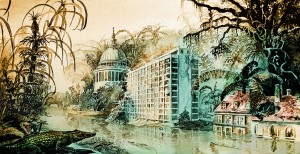Professor Michael Northcott, University of Edinburgh
PI of Caring for the Future through Ancestral Time, funded under AHRC Care for the Future: Thinking Forward through the Past
The global spread of a consumer culture, through electronic forms of communication, multinational trade networks, and airplane and shipping containers, creates a culture of instantaneity which changes human perceptions of time. At the same time rituals which used to marked the passage of the years, and linked time’s passing to daily life, are declining. Many of these rituals were associated with the planting, tending and harvesting of crops as determined by the seasons. The culture of instantaneity reflects a growing disconnect between culture and nature, and between consumption and production. This break was anticipated in the Victorian era when modern humans first migrated en masse from solar-powered fields and species to dwelling in fossil fuelled cities. As land for burials in crowded cities was scarce, the Victorians initiated a new rite of passage – cremation – which broke the visible link between human mortality and the earth. But the Victorians nonetheless built the infrastructure of their cities as if they intended them to last, even as most of their mortal remains were cremated and so ‘melted into air’.

Lichen on a grave stone of new red sandstone of the Permian era in the churchyard of an ecocongregation in Nithsdale, Southwest Scotland
Since the Victorian era, human powers have grown to the extent that natural scientists suggest industrial humans have inaugurated a new geological epoch – the Anthropcene. Homo industrialis is a ‘force of nature’, capable of shaping the geologic and evolutionary future of life on earth. Anthropogenic forcing of the earth system through changes in the refraction of solar heat energy from the earth’s surface to space, and species extinction many times the background extinction rate, are two of the ways in which a high consumption civilisation is challenging and changing the life support systems of the planet. But the time scale in which industrial greenhouse gas emissions provoke new climates which are observably different from pre-industrial climates, and the rate of industrial species extinction compared to pre-industrial, are not annual, but multi-decadal and even multi-centennial. Such long-term temporalities map poorly onto the presentist tendencies of consumer culture.
The cult of instantaneity and speed, combined with the long production and supply chains of global production systems, encourage citizens and corporations to neglect long run consideration, and the cost-benefit pathways which guide infrastructure and investment decisions are increasingly short term. Environmentalists argue for a greater attention towards ecological legacy in investment decisions in the light of the irreversible consequences of accelerated species extinctions, and of runaway anthropogenic climate change. However there is evidence that the apocalyptic terms in which environmentalists often narrate long run ecological consequences depoliticize decision-making processes and provoke denial (Bettini, 2013). This is partly because ecological apocalyptic represents the post-ecological future as radically changed from the present, as for example in J G Ballard’s Drowned World (1968) or Christopher Nolan’s film Interstellar (2014). Ecological apocalyptic may therefore fail to repair the short-termist tendencies of consumption and investment decision making.
Religious organisations sustain heritage sites, rituals and traditions that represent a ‘chain of memory’ between the past and the present (Herviue-Leger 2000). They engage stories from past lives – such as the lives of Moses, Christ and the Buddha – in ways that continue to shape daily life in the present. Religions also sustain eschatological imaginaries that link present actions to the future destinies of souls and the cosmos. In this project we call this awareness of past time in the present ‘ancestral time’. This understanding of time is reflected in the awareness of intergenerational community which Christians call the ‘communion of saints’, and which is annually celebrated at All Hallow’s Eve in secular as well as sacred customs and practices. Chinese have related customs, which may include maintenance of an ancestral altar in the home, or annual observation of the Feast of Hungry Ghosts. In these rituals and beliefs present generations are conscious of the presence of the past, of their debts to the dead, and of their legacy and responsibilities to future generations.
Memorials to the dead are among the oldest built structures in most cultures, including in Scotland, and often play an orienting role in the siting of places of dwelling and worship. For those who lived before the advent of the consumer society, reverence for the dead was connected with a sense of responsibility to the ancestors to live well, and to leave the earth in as good or better a condition as they left it. Reverence for ancestors symbolised the old idea of stewardship: that life is a gift and that diminishing the beauty or fertility of the land, or frittering away ancestrally acquired property, dishonours the dead.
Ancient grave stones on which engraving marks are eroded may be dated by counting the number of species of Lichen that they sustain (Leger and Forister 2009). Hence ‘Ancestral Time’ may represent an ecologically and culturally situated temporality that resists the dominant time management and economic accounting procedures of consumer society. In this approach church buildings, gravestones, clocks and church installations such as roof top solar panels, represent ‘objects of time’ (Birth 2013) that situate time in ecological and social worlds, and resist the instanteneity and virtuality of consumer time.
In this project we aim to discover whether ancestral time constitutes a representation of temporal experience that still has purchase in faith communities in their thinking and acting around ecological legacy. The project team are investigating this possibility through an ethnographic investigation of faith-based ecological activism. A key site of such activism is Eco-Congregation Scotland, which links 280 churches in the largest environmental network in Scotland. The project researchers are conducting interviews and participant observation at around 40 churches in the network. We are also investigating other faith based ecological activist networks, and comparative field studies in Transition Towns and other secular ecological networks.
If the long time scales that undergird natural scientific accounts of climate change and extinction are counter-cultural to contemporary moderns, they may map rather better onto the longer term life-time accounting that was common in the Christian era until the consumer age (Northcott 2014). In this project we are investigating the possibility that an ‘ancestral’ representation of intergenerational and ecological legacy may have cultural purchase within and beyond faith based communities in the quest for modes of existence that conserve ecological legacy for future generations.
Further details about the project can be found at:
http://ancestraltime.org.uk/about-the-project/
Project Blog: http://ancestraltime.org.uk/project-blog/
References and further reading
Ballard, J G (1962) The Drowned World Penguin, Harmondsworth.
Bettini, G (2013) Climate Barbarians at the Gate? A critique of apocalyptic narratives on ‘climate refugees’, Geoforum 45: 63 – 72.
Birth K (2012) Objects of Time: How Things Shape Temporality Palgrave MacMillan, New York.
Hervieu-Leger D. (2000), Religion as a Chain of Memory. Polity Press, Cambridge.
Leger E A and Forister M L (2009) Colonization, abundance, and geographic range size of gravestone lichens. Basic and Applied Ecology doi:10.1016/j.baae.2008.04.001
Nolan C (2014) Interstellar. Paramount, Los Angeles, CA.
Northcott M (2014) A Political Theology of Climate Change. SPCK, London
de Vos, Joppa et al (2014) Estimating the Normal Background Rate of Species Extinction. Conservation Biology DOI: 10.1111/cobi.12380
This post was originally uploaded on 18 November 2014. It was edited and had new images added on 19 November.


